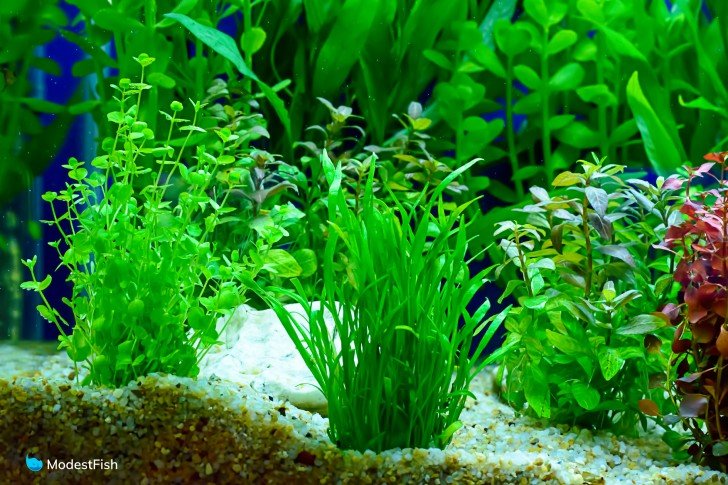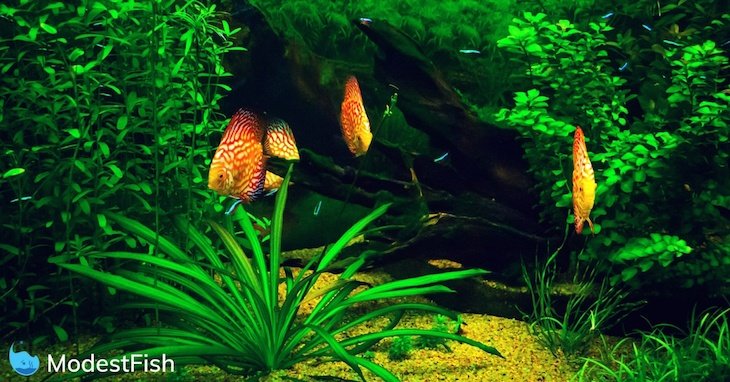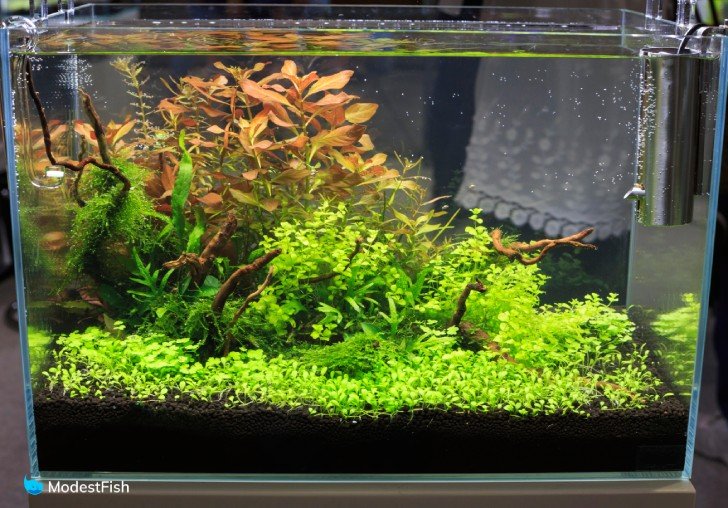Substrate is any material used on the bottom of your aquarium. But sand, gravel, and soil is what most aquarists use in planted tanks.
When ultilized correctly, substrates don’t only provide an anchor for plants or a surface for beneficial bacteria, but help provide a sense of depth and add to the visual appeal of a planted tank.
And luckily, aquarium plants can grow in all types of substrates, but that doesn’t mean all types of substrates are right for you.
In this guide, I’ll explain the pros and cons of different types of substrates and discuss which one might be best for you.
Best Types of Substrates for Planted Tanks
Before you go purchasing a nutrient-dense substrate for your tank, you first need to consider if you really need all those nutrients.
You have to kind of plant feeding types: root feeders and column feeders.
Root feeders will benefit from a nutrient dense aqua soil more than a column feeder who will primarily feed from the water.
A simple inert substrate may be more suitable for you than an expensive aquasoil if you’re only going to be keeping column feeders and supplement with liquid fertlizers.
Let’s discuss the different options below:
Sand (Inert Substrate)

Sand is a great choice for a beginner planted tank, just as long as it’s coarse. It’s cheap and easily obtained, and comes in loads of colors and sizes. However, you must ensure the sand grades are smaller than #3 (1mm-3mm), otherwise you can increase your risk of hydrogen sulfide forming during the nitrogen cycle.
If you want, you can add iron supplements to your aquarium to help control the hydrogen sulfide your plants can’t deal with. Having bottom feeders and/or burrowing snails can also help with this as they’ll routinely disturb the sand and help oxygenate it.
Sand won’t change your water parameters, but it also won’t provide any nutrients to heavy root feeding plants. So unless you’re going to supplement with root tabs, it might not be the right choice for you.
Personally, I don’t always advocate for beginners to get root tabs. I think you’d be just fine with sand substrate and an all-in-one liquid fertilizer.
If you want to use sand, lots of people have success with pool filter sand or an aquarium sand like Carib Sea Super Naturals Aquarium Sand.

Last update on 2024-04-22 / Commissions Earned / Images from Amazon Product Advertising API
Gravel (Inert Substrate)

Along with sand, gravel is another basic cheap and easily obtainable substrate. Again, using gravel won’t alter your water parameters, which is nice for beginners.
When it comes to plants, you’ll see similar results to sand. However, if your gravel grain size is more than 5mm, your plants may struggle to root properly.
However, if you really want larger grain, you can counter this by not using plants which require substrate. Epiphytes like java fern and anubias are better attached to hardscape. And floating plants require no attachment at all.
Again, it won’t have any nutrients, so you’ll need to dose your plants with liquid fertilizers.
If you’re thinking about adding gravel, you’ll need to consider which fish you will be keeping. Some fish may eat small pebbles (goldfish), and some could injure themselves on sharp gravel (betta fish).
So make sure you take this into account and choose accordingly.
Like sand, a huge benefit is you’ll never need to change the substrate out, it won’t color the water or change parameters. and you have a huge variety of looks available.
When choosing your gravel, just make sure your grain size is under 5mm and planting will be easy. Then it’s just a case of getting one you like the look of.
| Preview | Product | |
|---|---|---|

|
Seachem Flourite Black Clay Gravel - Stable Porous Natural Planted Aquarium Substrate 15.4 lbs | Buy on Amazon |

|
Seachem Fluorite Red Clay Gravel, 7.7 lb | Buy on Amazon |
Last update on 2024-04-22 / Commissions Earned / Images from Amazon Product Advertising API
Aqua Soil (Active Substrates)

Substrates like ADA aqua soil, Tropica, CaribSea Eco-Complete, Fluval Stratum all contain nutrients which are great if you want to keep root feeders.
These are active substrates, meaning they leach nutrients into your water column. And generally all plants in your tank will benefit from the nutrients they out put.
Aqua soils are associated with excellent plant growth and lush dense aquarium. often used in a high-tech setup in combinations with CO2 injection. However, you can still use these substrates without CO2.
They’re excellent for starting your nitrogen cycle because they tend to cause an ammonia spike. This does mean you should only add this substrate to a new tank with no fish. Once you’ve cycled your tank and tested the pH levels, you can add fish.
The big downside to aqua soils is there will come a time it is depleted. Typically, they last a year or so, after which you either break down the tank and rescape it or you remineralize.
Like mentioned above, they leech a lot of nutrients, which, don’t get me wrong they give you excellent plant growth, but if your plants can’t keep up with the nutrients, you’ll get massive algae blooms.
The only way to combat this is to either do daily 50% water changes for the first few weeks, or do something known as a dark start.
The dark start method is cycling the tank with no plants. You add just aqua soil and hardscape, and let it leach all the ammonia and nutrients. Once the tank is cycled, you change all the water out, add your plants, and you won’t experience a huge imbalance.
It can take a few weeks, but it can help skip a lot of headaches aqua soils cause in the early weeks.
If you want a densely planted aquarium with lots of root feeders and a nice carpet, aqua soil will be best for you.
But only use soil where you intend to plant. Otherwise, the soil can run into problems. Which brings me to my favorite substrate: a combination of soil and sand.
| Preview | Product | |
|---|---|---|

|
ADA Aqua Soil Amazonia Ver 2 (9L) | Buy on Amazon |

|
Seachem Flourite Black Clay Gravel - Stable Porous Natural Planted Aquarium Substrate 15.4 lbs | Buy on Amazon |

|
Fluval 12693 Plant and Shrimp Stratum for Freshwater Fish Tanks, 4.4 lbs. – Aquarium Substrate for... | Buy on Amazon |
Last update on 2024-04-22 / Commissions Earned / Images from Amazon Product Advertising API
Using Sand and Aqua Soil

One of my favorite combinations of substrates is using an aqua soil in areas I will plant and coarse sand in areas I won’t to create a more natural looking aquarium.
You can also then add some larger pebbles as details in order to make the tank more realistic.
Using Potting Soil as a Substrate
Using potting soil, also known as a dirted tank, has grown in popularity and is something many aquarists have had great success with.
Personally, I don’t want to recommend you what to do here, as I haven’t ever owned a dirted tank myself. But, if you want to learn more, I highly recommend you check out the book Ecology of the Planted Tank by Diana Walstad.
Which Substrate Will You Use?
Choosing substrate is a personal decision. You can grow aquarium plants with all mentioned in this article. Personally, I like to combine multiple as I think it has a very natural aesthetic and fits well with plants.
If you go the aqua soil route, you really can create some beautiful planted tanks, you just need to be aware of the drawbacks and extra work upfront you have to do.
I would also highly recommend you check out the book Ecology of the Planted Tank and give yourself a deeper understanding on how planted tanks function and the role of substrate in the aquarium.
| Preview | Product | |
|---|---|---|

|
ADA Aqua Soil Amazonia Ver 2 (9L) | Buy on Amazon |

|
Seachem Flourite Black Clay Gravel - Stable Porous Natural Planted Aquarium Substrate 15.4 lbs | Buy on Amazon |

|
Fluval 12693 Plant and Shrimp Stratum for Freshwater Fish Tanks, 4.4 lbs. – Aquarium Substrate for... | Buy on Amazon |

|
Carib Sea Super Naturals Aquarium Sand, 10 lbs., Tan | Buy on Amazon |

|
Seachem Flourite Black Clay Gravel - Stable Porous Natural Planted Aquarium Substrate 15.4 lbs | Buy on Amazon |
Last update on 2024-04-22 / Commissions Earned / Images from Amazon Product Advertising API

Your article is the best on substrate for planted aquarium that I have read so far.
Any one that reads this article will know which substrate to purchase.My sincere congratulations.
thank you so much for your valuable article.it was really a great help for me as a beginner
The production of hydrogen sulfide is a myth. It instantly bonds to oxygen molecules in the water. Check out some of the expert chemist fishkeepers on youtube.
Thank you for your comment, Simon. That’s certainly an interesting point you make. Could you provide me with some links to your sources? I’d love to check them out.
Hi, thank you for this very good article.
I plan to setup a tank and I am therefore looking for what kind of substrate to use and your article helps me a lot for this choice.
I have some questions that perhaps you may be able to answer :
– What is the lifespan of all these substrates?
– When you said for ADA Aquasoil that “nutrients will be good in your tank
for a year” and after what’s happening?
Thank-you per advance
Thank you for your comment. So as your plants feed off of the nutrients in the substrate, they’ll be used up. After a year, you may be required to dose your soil to replenish the nutrients.
Hi there. Very good article to read. By the way,i have a question.
If i use Caribsea Eco complete, do i need to layer them with gravel on top or do i need to add soil under neath it? can please advise on how to multilayer it? Or is it necessary to multilayer?
Thank you for the advise
Thank you for your comment :D. You don’t have to do a multi-layer, but if it was me, I would put gravel on top of Caribsea Eco complete.
good article, I have used seachem, not so good… eco complete great stuff for any plant, the only thing I noticed is my bottom feeders which by the way I have mostly cichlids… found it abrasive … freaked out on it… super hard and pointy, I found that the caribsea gravel is great… for my fish only tank….
Hi. I’m wondering if I would need to replace any of this substrate if i was using hardy plants like java fern, anubia, hornwart etc. Also, would standard LED lighting work fine for most plants? TIA
Hi Rachel. Java fern and anubias, hornwart would be fine. Yes most standard LED lighting will work for most plants. We tested some different LED lights here https://modestfish.com/best-led-lighting-planted-aquarium/